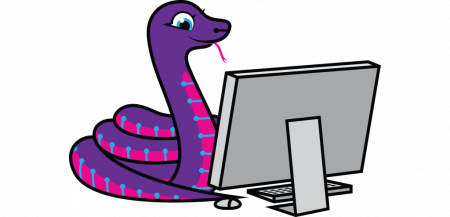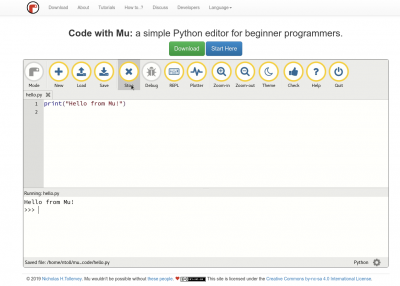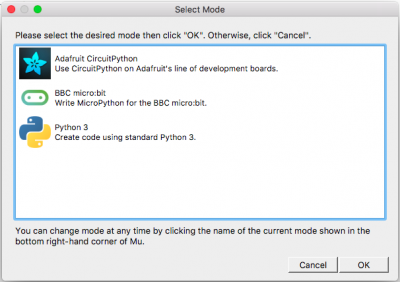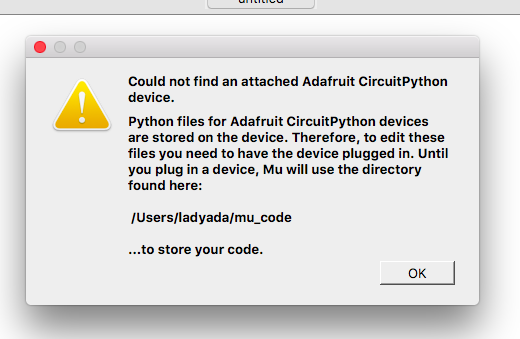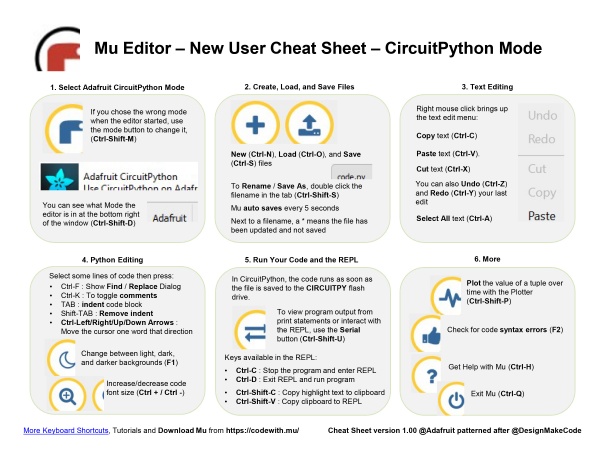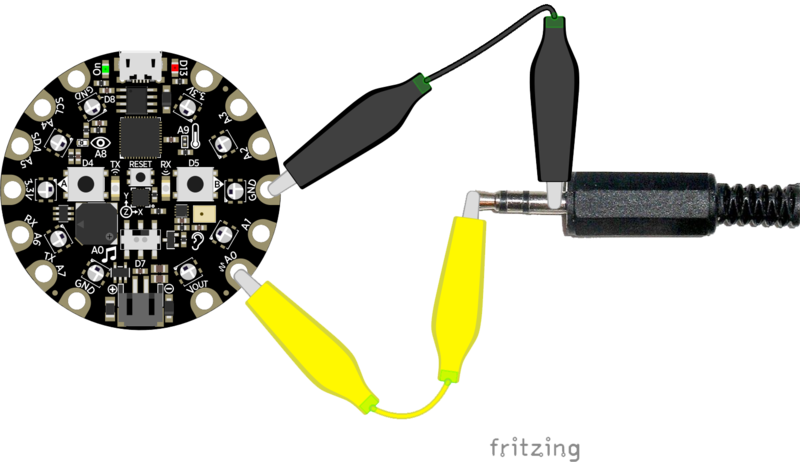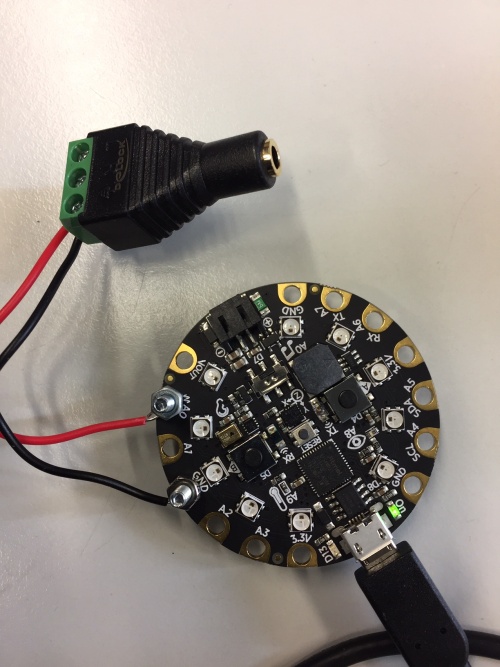Difference between revisions of "Tinkering workshop"
| Line 432: | Line 432: | ||
<syntaxhighlight lang="python" line='line'> | <syntaxhighlight lang="python" line='line'> | ||
| − | |||
import board | import board | ||
from adafruit_circuitplayground import cp | from adafruit_circuitplayground import cp | ||
| Line 438: | Line 437: | ||
import pulseio | import pulseio | ||
import array | import array | ||
| − | import | + | import sys |
| − | |||
# change into your own color by changing the rgb value | # change into your own color by changing the rgb value | ||
| − | myID_colour=(0,255, | + | myID_colour = (100, 55, 50) |
| − | # NeoPixel brightness | + | OFF = (0, 0, 0) |
| + | color_got_hit = (255, 0, 0) | ||
| + | color_got_saved = (100, 0, 100) | ||
| + | Neo_smiley_face = [1, 3, 5, 6, 7, 8, 9, 10] | ||
| + | full_board_led = [0, 1, 2, 3, 4, 5, 6, 7, 8, 9, 10] | ||
| + | counter = 0 | ||
| + | lifes = 10-counter | ||
| + | |||
| + | # Initializes NeoPixel ring | ||
| + | cp.pixels.brightness = 0.2 | ||
| + | # my id color | ||
| + | cp.pixels.fill(myID_colour) | ||
| + | |||
# Create IR input, maximum of 59 bits. | # Create IR input, maximum of 59 bits. | ||
| Line 480: | Line 490: | ||
return True | return True | ||
| − | + | ||
| − | |||
| − | |||
| − | |||
| − | |||
# serial print once when activated | # serial print once when activated | ||
| Line 490: | Line 496: | ||
while True: | while True: | ||
| − | # when button is pressed, send IR pulse | + | # when button is pressed, send IR pulse |
| − | # detection is paused then cleared and resumed after a short pause | + | # detection is paused then cleared and resumed after a short pause |
| − | # this prevents reflected detection of own IR | + | # this prevents reflected detection of own IR |
while cp.touch_A3: | while cp.touch_A3: | ||
pulseIn.pause() # pauses IR detection | pulseIn.pause() # pauses IR detection | ||
| Line 506: | Line 512: | ||
pulseIn.resume() | pulseIn.resume() | ||
# Wait for a pulse to be detected of desired length | # Wait for a pulse to be detected of desired length | ||
| − | + | # our array is 59 bytes so anything shorter ignore | |
| + | while len(pulseIn) >= 59: | ||
pulseIn.pause() | pulseIn.pause() | ||
# converts pulseIn raw data into useable array | # converts pulseIn raw data into useable array | ||
| Line 517: | Line 524: | ||
print('Received correct Button A control press!') | print('Received correct Button A control press!') | ||
t_end = time.monotonic() + 0.8 # saves time 2 seconds in the future | t_end = time.monotonic() + 0.8 # saves time 2 seconds in the future | ||
| − | while time.monotonic() < t_end: | + | while time.monotonic() < t_end: |
| + | |||
for x in range(10): | for x in range(10): | ||
| − | if x!= 0 and x!=2 and x!=4: | + | cp.pixels[x] = OFF |
| − | cp.pixels[x]=( | + | for x in range(10): |
| + | if x != 0 and x != 2 and x != 4: | ||
| + | cp.pixels[x] = (color_got_saved) | ||
| + | cp.play_file("rise.wav") | ||
| + | time.sleep(0.2) | ||
| + | |||
| + | if counter < 10 and counter > 0: | ||
| + | counter = counter-1 | ||
| + | lifes = 10-counter | ||
| + | for x in range(10): | ||
| + | cp.pixels[x] = OFF | ||
| + | else: | ||
| + | for i in range(lifes): | ||
| + | cp.pixels[full_board_led[i]] = myID_colour | ||
| + | pulseIn.clear() | ||
| + | pulseIn.resume() | ||
| + | |||
| + | |||
| − | |||
| − | |||
| − | |||
| − | |||
| − | |||
if fuzzy_pulse_compare(pulse_B, detected): | if fuzzy_pulse_compare(pulse_B, detected): | ||
| Line 532: | Line 552: | ||
t_end = time.monotonic() + 0.8 | t_end = time.monotonic() + 0.8 | ||
while time.monotonic() < t_end: | while time.monotonic() < t_end: | ||
| − | + | print(counter) | |
| − | cp.pixels. | + | print(lifes) |
| − | cp.play_file(" | + | for x in range(10): |
| − | time.sleep(0. | + | cp.pixels[x] = OFF |
| − | + | for x in range(10): | |
| + | cp.pixels[x] = (color_got_hit) | ||
| + | cp.play_file("dip.wav") | ||
| + | time.sleep(0.2) | ||
| + | counter = counter+1 | ||
| + | lifes = 10-counter | ||
| + | if lifes < 1: | ||
| + | sys.exit() | ||
| + | for x in range(10): | ||
| + | cp.pixels[x] = OFF | ||
| + | for i in range(lifes): | ||
| + | cp.pixels[full_board_led[i]] = myID_colour | ||
| + | else: | ||
| + | for i in range(lifes): | ||
| + | cp.pixels[full_board_led[i]] = myID_colour | ||
| + | pulseIn.clear() | ||
| + | pulseIn.resume() | ||
time.sleep(.1) | time.sleep(.1) | ||
pulseIn.clear() | pulseIn.clear() | ||
pulseIn.resume() | pulseIn.resume() | ||
| + | |||
</syntaxhighlight> | </syntaxhighlight> | ||
Revision as of 17:44, 8 April 2021
Yoana:
introduction on Adafruit Circuit Playground Express
install CircuitPython
install mu editor
Interacting to the Serial Console
The REPL
short cuts:
Indentation and commenting options
Python programs are Space holder Character Sensitive.
To indent the three lines, I selected them all and then pressed the Tab key.
To unindent, select some lines and press Shift-Tab. For commenting: select lines and press command(control)-k
http://interactionstation.wdka.hro.nl/wiki/Cpx-basic
Nan==
install library..
examples:
library CircuitPython Made Easy
1. Smiley face with NeoPixels
2. Capacitive Touch & NeoPixels
3. Play audio file
4. Drum machine
5. final infrared tagging games(maybe)
timing / schedule
start 13:00 end 17:00
13:00 - 14:00 Yoana introduction part
14:00 - 14:15 - break
14:15 - 16:00 Nan's part
16:00 - 16:15 break
16:15 - 17:00 Play
Introduction on Adafruit Circuit Playground Express
Install CircuitPython
Install mu editor
Python is the fastest-growing programming language. And CircuitPython is based on Python language but designed to run on microcontroller boards.
CircuitPython is designed with education in mind.
It's easy to start learning how to program and you get immediate feedback from the board.
Before we start we all have to do this to set up:
1. Install or update CircuitPython!
https://learn.adafruit.com/adafruit-circuit-playground-express/circuitpython-quickstart
*1. Click the link below and download the latest UF2 file: https://circuitpython.org/board/circuitplayground_express/
*2. Plug your Circuit Playground Express into your computer via a (data)USB cable.
*3. Double-click the small Reset button in the middle of the CPX(short for circuit playground express). you will see all of the LEDs turn green. If they turn all red, check the USB cable, try another USB port, etc. (If double-clicking doesn't do it, try a single-click!)
*4. You will see a new disk drive appear called CPLAYBOOT Drag the adafruit-circuitpython-etc...uf2 file onto it.
*5. The CPLAYBOOT drive will disappear and a new disk drive will appear called CIRCUITPY
That's it! You're done :)
2. Installing Mu Editor
Download Mu from(if you are using computers from school, the Mu Editor is already installed)
The first time you start Mu, you will be prompted to select your 'mode' -
you can always change your mind later. For now please select CircuitPython!
Mu attempts to auto-detect your board, so please plug in your CircuitPython device and make sure it shows up as a CIRCUITPY drive before starting Mu
Indentation and commenting options
Python programs are Space holder Character Sensitive.
To indent the three lines, I selected them all and then pressed the Tab key.
To unindent, select some lines and press Shift-Tab. For commenting: select lines and press command(control)-k
3. Hello World (Blink in Circuitpython)
1 import board
2 import digitalio
3 import time
4
5 led = digitalio.DigitalInOut(board.D13)
6 led.direction = digitalio.Direction.OUTPUT
7
8 while True:
9 led.value = True
10 time.sleep(0.5)
11 led.value = False
12 time.sleep(0.5)
4. Interacting to the Serial Console
The REPL
The other feature of the serial connection is the Read-Evaluate-Print-Loop, or REPL.
The REPL allows you to enter individual lines of code and have them run immediately.
It's really handy if you're running into trouble with a particular program and can't figure out why.
It's interactive so it's great for testing new ideas.
To use the REPL, you first need to be connected to the serial console.
Once that connection has been established, you'll want to press Ctrl + C.
If there is code running, it will stop and you'll see Press any key to enter the REPL. Use CTRL-D to reload.
Follow those instructions, and press any key on your keyboard.
https://learn.adafruit.com/adafruit-circuit-playground-express/the-repl
CircuitPython Made Easy
Libraries:
Libraries are codes other people have written for you. The libraries we will be using are included as part of the CircuitPython code, but you still must import them into your program. Other libraries, for many uses, must be downloaded and placed in a folder named lib on the CIRCUITPY drive.
CircuitPython Libraries already included in CPX, But if you are using CPB, (CPX = Circuit Playground Express, CPB = Circuit Playground Bluefruit)
you need to install CircuitPython Libraries by download the file and put them in the folder named lib on the CIRCUITPY drive.
we will useCircuitPython Made Easy libraries, a simple way to include the Circuit Playground functionality in our code.
more reference and examples:
https://learn.adafruit.com/circuitpython-made-easy-on-circuit-playground-express
code examples
Neopixel smiley face
A Smiley Face😊
1from adafruit_circuitplayground import cp
2
3# The NeoPixels are super-bright. Change the global brightness.
4cp.pixels.brightness = 0.3
5
6while True:
7 # The smiley's eyes
8 cp.pixels[1] = (255, 0, 0)
9 cp.pixels[3] = (255, 0, 0)
10
11 # The smiley's mouth
12 cp.pixels[5] = (255, 0, 255)
13 cp.pixels[6] = (255, 0, 255)
14 cp.pixels[7] = (255, 0, 255)
15 cp.pixels[8] = (255, 0, 255)
16 cp.pixels[9] = (255, 0, 255)
Let's blink a smiley face by using time.sleep
1from adafruit_circuitplayground import cp
2
3# The NeoPixels are super-bright. Change the global brightness.
4cp.pixels.brightness = 0.3
5
6import time
7
8while True:
9 time.sleep(1)
10 # The smiley's eyes
11 cp.pixels[1] = (255, 0, 0)
12 cp.pixels[3] = (255, 0, 0)
13
14 # The smiley's mouth
15 cp.pixels[5] = (255, 0, 255)
16 cp.pixels[6] = (255, 0, 255)
17 cp.pixels[7] = (255, 0, 255)
18 cp.pixels[8] = (255, 0, 255)
19 cp.pixels[9] = (255, 0, 255)
20 time.sleep(1)
21
22 # The smiley's eyes
23 cp.pixels[1] = (0, 0, 0)
24 cp.pixels[3] = (0, 0, 0)
25
26 # The smiley's mouth
27 cp.pixels[5] = (0, 0, 0)
28 cp.pixels[6] = (0, 0, 0)
29 cp.pixels[7] = (0, 0, 0)
30 cp.pixels[8] = (0, 0, 0)
31 cp.pixels[9] = (0, 0, 0)
hmm... now the code seems to be too long
let's Shorten the code by implementing variables, "for" loops
1import time
2from adafruit_circuitplayground import cp
3#neoPixel pins for the smiley face
4pixels_pin=[1, 3, 5, 6, 7, 8, 9,10]
5# The NeoPixels are super-bright. Change the global brightness.
6cp.pixels.brightness = 0.1
7light_colour=(105,0,105)
8OFF=(0,0,0)
9
10while True:
11 for i in range (7):
12 cp.pixels[pixels_pin[i]]=light_colour
13 time.sleep(1)
14 for i in range (7):
15 cp.pixels[pixels_pin[i]]=OFF
16 time.sleep(1)
much better!!! now if you add a time.sleep(0.5) in the for loop you will see a fading animation of the smiley face.
Touch sense
there are in total 7 touch pins on CPX. let's try to use the touch sensor to trigger the smiley face.
1import time
2from adafruit_circuitplayground import cp
3#neoPixel pins for the smiley face
4pixels_pin=[1, 3, 5, 6, 7, 8, 9,10]
5# The NeoPixels are super-bright. Change the global brightness.
6cp.pixels.brightness = 0.1
7light_colour=(105,0,105)
8OFF=(0,0,0)
9
10while True:
11 if cp.touch_A4:
12 for i in range (7):
13 cp.pixels[pixels_pin[i]]=light_colour
14 time.sleep(.1)
15 print("A4-touched!")
16 else:
17 for i in range (7):
18 cp.pixels[pixels_pin[i]]=OFF
19 time.sleep(.1)
play audio file
1import time
2from adafruit_circuitplayground import cp
3#neoPixel pins for the smiley face
4pixels_pin=[1, 3, 5, 6, 7, 8, 9,10]
5
6# The NeoPixels are super-bright. Change the global brightness.
7cp.pixels.brightness = 0.1
8colour01=(105,0,105)
9colour02=(0,100,105)
10OFF=(0,0,0)
11
12while True:
13 if cp.touch_A4:
14 for i in range (7):
15 cp.pixels[pixels_pin[i]]=colour01
16 time.sleep(0.03)
17 print("A4-touched!")
18 cp.play_file("rise.wav")
19 else:
20 for i in range (7):
21 cp.pixels[pixels_pin[i]]=OFF
22 time.sleep(0.03)
23 if cp.touch_A3:
24 for i in range (7):
25 cp.pixels[pixels_pin[i]]=colour02
26 time.sleep(0.03)
27 print("A3-touched!")
28
29 cp.play_file("dip.wav")
30 else:
31 for i in range (7):
32 cp.pixels[pixels_pin[i]]=OFF
33 time.sleep(0.03)
Drum Machine
https://learn.adafruit.com/adafruit-circuit-playground-express/playground-drum-machine
copy the drum samples there:
[samples]
1# Circuit Playground 808 Drum machine
2import time
3import board
4import touchio
5import digitalio
6
7try:
8 from audiocore import WaveFile
9except ImportError:
10 from audioio import WaveFile
11
12try:
13 from audioio import AudioOut
14except ImportError:
15 try:
16 from audiopwmio import PWMAudioOut as AudioOut
17 except ImportError:
18 pass # not always supported by every board!
19
20bpm = 120 # Beats per minute, change this to suit your tempo
21
22# Enable the speaker
23speaker_enable = digitalio.DigitalInOut(board.SPEAKER_ENABLE)
24speaker_enable.direction = digitalio.Direction.OUTPUT
25speaker_enable.value = True
26
27# Make the input capacitive touchpads
28capPins = (board.A1, board.A2, board.A3, board.A4, board.A5,
29 board.A6, board.TX)
30
31touchPad = []
32for i in range(7):
33 touchPad.append(touchio.TouchIn(capPins[i]))
34
35# The seven files assigned to the touchpads
36audiofiles = ["bd_tek.wav", "elec_hi_snare.wav", "elec_cymbal.wav",
37 "elec_blip2.wav", "bd_zome.wav", "bass_hit_c.wav",
38 "drum_cowbell.wav"]
39
40audio = AudioOut(board.SPEAKER)
41
42
43def play_file(filename):
44 print("playing file " + filename)
45 file = open(filename, "rb")
46 wave = WaveFile(file)
47 audio.play(wave)
48 time.sleep(bpm / 960) # Sixteenth note delay
49
50
51while True:
52 for i in range(7):
53 if touchPad[i].value:
54 play_file(audiofiles[i])
connect to a proper speaker:
we can use A0 and GND as audio output and connect it to a proper speaker.
you can use M3 bolts and nuts to fix the electrical wire on the circuit playground express.
infrared tagging game:
1import board
2from adafruit_circuitplayground import cp
3import time
4import pulseio
5import array
6import sys
7
8# change into your own color by changing the rgb value
9myID_colour = (100, 55, 50)
10OFF = (0, 0, 0)
11color_got_hit = (255, 0, 0)
12color_got_saved = (100, 0, 100)
13Neo_smiley_face = [1, 3, 5, 6, 7, 8, 9, 10]
14full_board_led = [0, 1, 2, 3, 4, 5, 6, 7, 8, 9, 10]
15counter = 0
16lifes = 10-counter
17
18# Initializes NeoPixel ring
19cp.pixels.brightness = 0.2
20# my id color
21cp.pixels.fill(myID_colour)
22
23
24# Create IR input, maximum of 59 bits.
25pulseIn = pulseio.PulseIn(board.IR_RX, maxlen=59, idle_state=True)
26# Clears any artifacts
27pulseIn.clear()
28pulseIn.resume()
29
30# Creates IR output pulse
31pwm = pulseio.PWMOut(board.IR_TX, frequency=38000, duty_cycle=2 ** 15)
32pulse = pulseio.PulseOut(pwm)
33
34# Array for button A pulse, this is the pulse output when the button is pressed
35# Inputs are compared against this same array
36# array.array('H', [x]) must be used for IR pulse arrays when using pulseio
37# indented to multiple lines so its easier to see
38pulse_A = array.array('H', [1000, 3800, 65000, 950, 300, 200, 300, 1000, 350, 175,
39 275, 215, 275, 250, 275, 215, 275, 225, 275, 215, 275, 1000, 300, 225, 275,
40 950, 300, 950, 300, 1000, 300, 950, 300, 250, 275, 700, 300, 950, 300, 450,
41 300, 475, 300, 215, 275, 725, 300, 950, 300, 200, 300, 715, 325, 900, 315,
42 425, 315, 1000, 65000])
43pulse_B = array.array('H', [1000, 3800, 65000, 960, 300, 200, 300, 950, 350, 190,
44 215, 245, 300, 225, 275, 225, 275, 215, 275, 200, 300, 700, 300, 200, 300,
45 700, 300, 1000, 315, 675, 300, 1000, 300, 200, 300, 700, 300, 950, 300,
46 950, 300, 700, 300, 700, 300, 450, 300, 475, 275, 715, 300, 225, 275, 450,
47 300, 450, 300, 1000, 65000])
48
49# Fuzzy pulse comparison function. Fuzzyness is % error
50def fuzzy_pulse_compare(pulse1, pulse2, fuzzyness=0.5):
51 if len(pulse1) != len(pulse2):
52 return False
53 for i in range(len(pulse1)):
54 threshold = int(pulse1[i] * fuzzyness)
55 if abs(pulse1[i] - pulse2[i]) > threshold:
56 return False
57 return True
58
59
60
61# serial print once when activated
62print('IR Activated!')
63
64while True:
65 # when button is pressed, send IR pulse
66 # detection is paused then cleared and resumed after a short pause
67 # this prevents reflected detection of own IR
68 while cp.touch_A3:
69 pulseIn.pause() # pauses IR detection
70 pulse.send(pulse_A) # sends IR pulse
71 time.sleep(.2) # wait so pulses dont run together
72 pulseIn.clear() # clear any detected pulses to remove partial artifacts
73 pulseIn.resume() # resumes IR detection
74 while cp.touch_A4:
75 pulseIn.pause()
76 pulse.send(pulse_B)
77 time.sleep(.2)
78 pulseIn.clear()
79 pulseIn.resume()
80# Wait for a pulse to be detected of desired length
81 # our array is 59 bytes so anything shorter ignore
82 while len(pulseIn) >= 59:
83 pulseIn.pause()
84# converts pulseIn raw data into useable array
85 detected = array.array('H', [pulseIn[x] for x in range(len(pulseIn))])
86# print(len(pulseIn))
87# print(detected)
88
89 # Got a pulse, now compare against stored pulse_A and pulse_B
90 if fuzzy_pulse_compare(pulse_A, detected):
91 print('Received correct Button A control press!')
92 t_end = time.monotonic() + 0.8 # saves time 2 seconds in the future
93 while time.monotonic() < t_end:
94
95 for x in range(10):
96 cp.pixels[x] = OFF
97 for x in range(10):
98 if x != 0 and x != 2 and x != 4:
99 cp.pixels[x] = (color_got_saved)
100 cp.play_file("rise.wav")
101 time.sleep(0.2)
102
103 if counter < 10 and counter > 0:
104 counter = counter-1
105 lifes = 10-counter
106 for x in range(10):
107 cp.pixels[x] = OFF
108 else:
109 for i in range(lifes):
110 cp.pixels[full_board_led[i]] = myID_colour
111 pulseIn.clear()
112 pulseIn.resume()
113
114
115
116
117 if fuzzy_pulse_compare(pulse_B, detected):
118 print('Received correct Button B control press!')
119 t_end = time.monotonic() + 0.8
120 while time.monotonic() < t_end:
121 print(counter)
122 print(lifes)
123 for x in range(10):
124 cp.pixels[x] = OFF
125 for x in range(10):
126 cp.pixels[x] = (color_got_hit)
127 cp.play_file("dip.wav")
128 time.sleep(0.2)
129 counter = counter+1
130 lifes = 10-counter
131 if lifes < 1:
132 sys.exit()
133
134 for x in range(10):
135 cp.pixels[x] = OFF
136 for i in range(lifes):
137 cp.pixels[full_board_led[i]] = myID_colour
138
139 else:
140 for i in range(lifes):
141 cp.pixels[full_board_led[i]] = myID_colour
142 pulseIn.clear()
143 pulseIn.resume()
144
145 time.sleep(.1)
146 pulseIn.clear()
147 pulseIn.resume()
